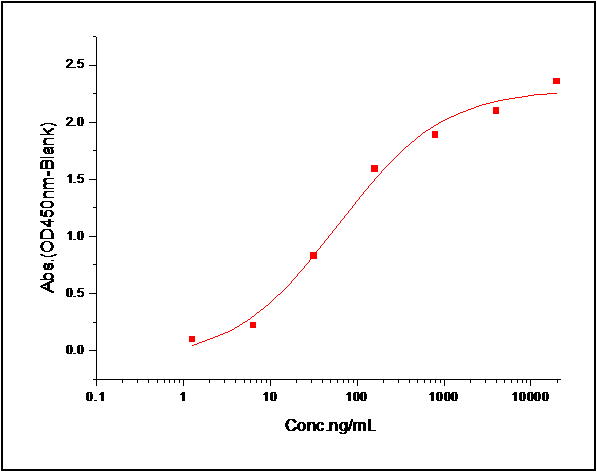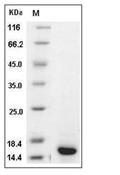Shopping Cart
Remove All Your shopping cart is currently empty
Your shopping cart is currently empty
S100A9 Protein, Human, Recombinant (His) is expressed in Baculovirus insect cells with His tag. The predicted molecular weight is 14.6 kDa and the accession number is P06702.

| Pack Size | Price | USA Warehouse | Global Warehouse | Quantity |
|---|---|---|---|---|
| 5 μg | $48 | - | In Stock | |
| 10 μg | $75 | - | In Stock | |
| 20 μg | $118 | - | In Stock | |
| 50 μg | $229 | 7-10 days | 7-10 days | |
| 100 μg | $386 | - | In Stock | |
| 200 μg | $682 | 7-10 days | 7-10 days | |
| 500 μg | $1,430 | 7-10 days | 7-10 days |
| Biological Activity | Measured by its binding ability in a functional ELISA. Immobilized S100A8-His at 10 μg/ml (100 μl/well) can bind S100A9-His , The EC50 of S100A9-His is 0.35-0.70 μg/mL.  |
| Description | S100A9 Protein, Human, Recombinant (His) is expressed in Baculovirus insect cells with His tag. The predicted molecular weight is 14.6 kDa and the accession number is P06702. |
| Species | Human |
| Expression System | Baculovirus Insect Cells |
| Tag | C-His |
| Accession Number | P06702 |
| Synonyms | S100 calcium binding protein A9,P14,NIF,MRP-14,MRP14,MIF,MAC387,LIAG,L1AG,CGLB,CFAG,CAGB,60B8AG |
| Construction | A DNA sequence encoding the human S100A9 (NP_002956.1) (Met 1-Pro 114) was expressed, fused with a polyhistidine tag at the C-terminus. Predicted N terminal: Met |
| Protein Purity | > 95 % as determined by SDS-PAGE  |
| Molecular Weight | 14.6 kDa (predicted); 16 kDa (reducing conditions) |
| Endotoxin | < 1.0 EU/μg of the protein as determined by the LAL method. |
| Formulation | Lyophilized from a solution filtered through a 0.22 μm filter, containing PBS, pH 7.4. Typically, a mixture containing 5% to 8% trehalose, mannitol, and 0.01% Tween 80 is incorporated as a protective agent before lyophilization. |
| Reconstitution | A Certificate of Analysis (CoA) containing reconstitution instructions is included with the products. Please refer to the CoA for detailed information. |
| Stability & Storage | It is recommended to store recombinant proteins at -20°C to -80°C for future use. Lyophilized powders can be stably stored for over 12 months, while liquid products can be stored for 6-12 months at -80°C. For reconstituted protein solutions, the solution can be stored at -20°C to -80°C for at least 3 months. Please avoid multiple freeze-thaw cycles and store products in aliquots. |
| Shipping | In general, Lyophilized powders are shipping with blue ice. |
| Research Background | S100 protein is a family of low molecular weight protein found in vertebrates characterized by two EF-hand calcium-binding motifs. There are at least 21 different S100 proteins, and the name is derived from the fact that the protein is 100% soluble in ammonium sulfate at neutral pH. Most S100 proteins are disulfide-linked homodimer, and is normally present in cells derived from the neural crest, chondrocytes, macrophages, dendritic cells, etc. S100 proteins have been implicated in a variety of intracellular and extracellular functions. They are involved in regulation of protein phosphorylation, transcription factors, the dynamics of cytoskeleton constituents, enzyme activities, cell growth and differentiation, and the inflammatory response. Protein S100-A9, also known as S100 calciumbinding protein A9, S100A9, and CAGB, is a member of the S-100 family. S100A9 is expressed by macrophages in acutely inflammed tissues and in chronic inflammation. It is also expressed in epithelial cells constitutively or induced during dermatoses. S100A9 is a calcium-binding protein. It has anti-microbial activity towards bacteria and fungi. The anti-microbial and proapoptotic activity of S100A9 is inhibited by zinc ions. S100A9 plays a role in the development of endotoxic shock in response to bacterial lipopolysaccharide (LPS). It promotes tubulin polymerization when unphosphorylated. It also promotes phagocyte migration and infiltration of granulocytes at sites of wounding. S100A9 plays a role as a proinflammatory mediator in acute and chronic inflammation and up-regulates the release of IL8 and cell-surface expression of ICAM1. |
| Size | Quantity | Unit Price | Amount | Operation |
|---|

Copyright © 2015-2026 TargetMol Chemicals Inc. All Rights Reserved.